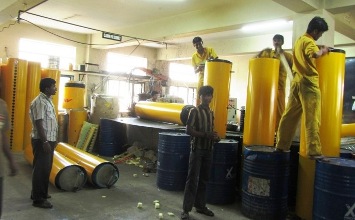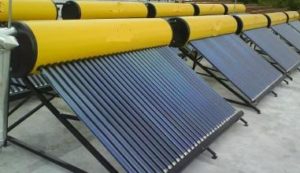India: Revised Technical Specifications for How to Install and Insulate Solar Water Heaters
December 30, 2011
Tank manufacturing at Indian company Anu Solar
After publishing the Memorandum “Minimum Requirements for Installation of Solar Water Heating Systems in Field” in September 2011, India’s Ministry of New and Renewable Energy issued a revised version of the guidelines on 25 November 2011. The Solar Thermal Federation of India (STFI) has successfully intervened against certain of its requirements. The photo shows the tank manufacturing at Indian company Anu Solar.
Photo: Anu Solar
In the September guidelines, the ministry stated that the thermal insulation of tanks & hot water piping should have been at least 50 mm thick. They should have also had a CFC-free polyurethane foam (PUF) insulation with a density of 28-32 kg/m3 (CFC stands for chlorofluorocarbons), which was to be doubled in regions with sub-zero temperatures. Manufacturers whose commercially available products did not meet the specifications were removed from the list of approved manufacturers.
The regulation has not found any support on the side of the manufacturers. On the contrary, they expressed concerns over the technical feasibility of the approved technologies. Davinder Kaushal from tank and collector manufacturer Inter Solar Systems says: “It is possible to use PUF insulation up to a capacity of 500 litres per day (lpd). Systems above 500 lpd should better be insulated with 100 mm thick rock wool of 48 kg/m3 density, together with either aluminium or powder-coated cladding”. Surendra Kumar from competitor Nuetech Solar explains that the tank PUF insulation is processed in-house and requires bulky machinery, which means carrying machines to the site is not a very practical solution. For capacities beyond 500 lpd, the pre-insulated tank gets heavy enough to cause damage particularly on high-rise buildings.
The intervention by STFI led to an adaptation of the guidelines – which means that in the revised version, rock wool insulation is now eligible for both tanks and pipes (see the attached document).
 In areas with high-wind loads, the panel is mounted on concrete ingots (grouted).
In areas with high-wind loads, the panel is mounted on concrete ingots (grouted).
Photo: hjsolar.en.alibaba.com/
The second revised passage is about how to mount the solar water heater on the roof. The September guidelines stipulated to – in any case – “grout and clamp the collectors well”. The industry argued that this would lead to increasing costs, because it required additional material and work. So the guideline was changed to “systems installed in high windy areas shall be well grouted / clamped by setting up the collectors in a way that makes it possible for them to sustain the highest wind pressure in that area” (see the attached PDF). The majority of the top manufacturers expressed their satisfaction about this change.


